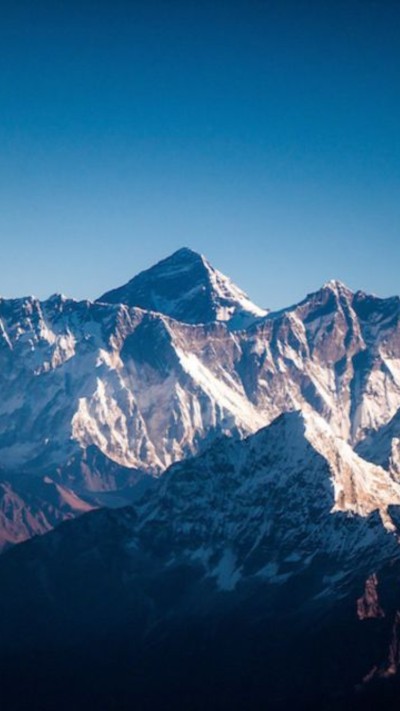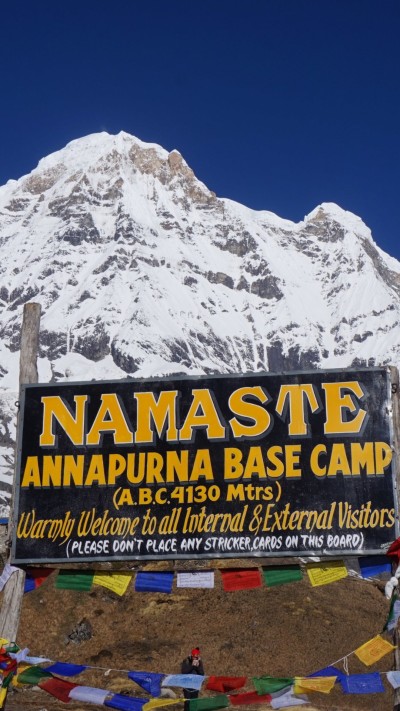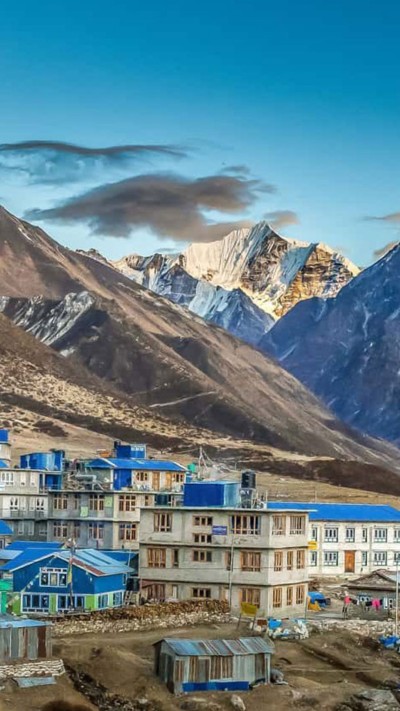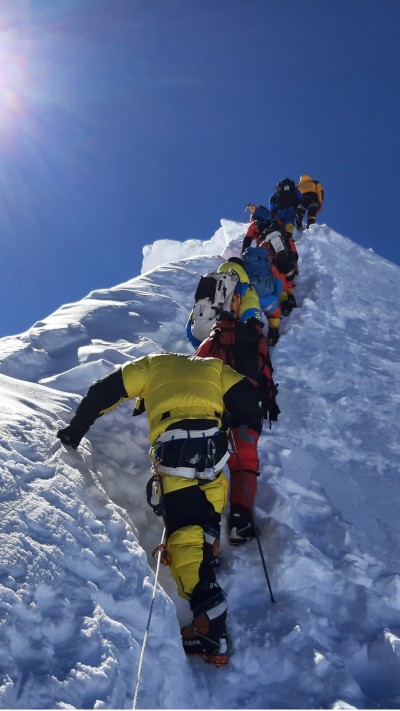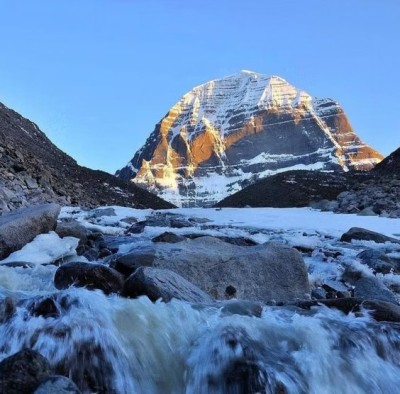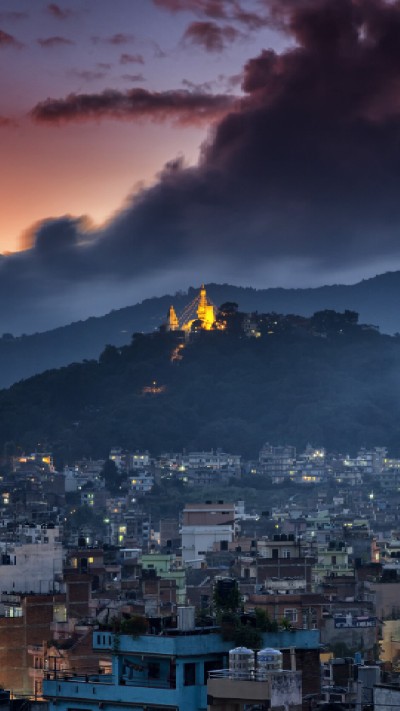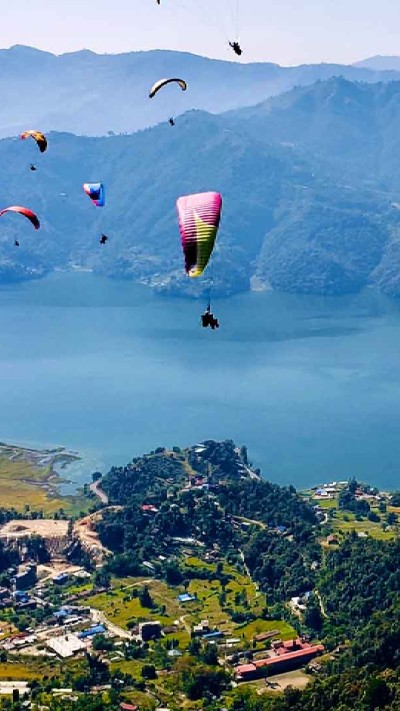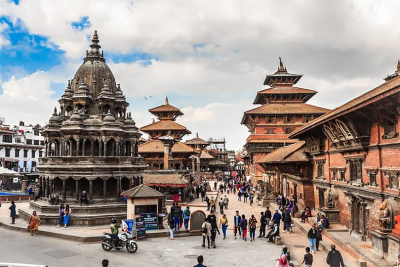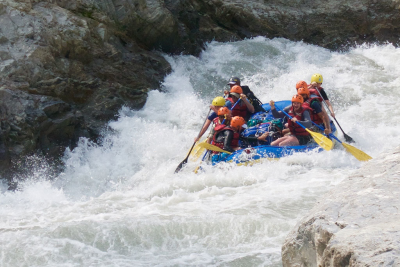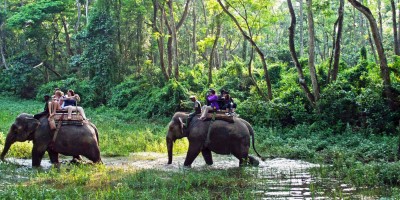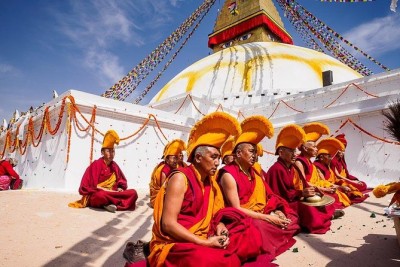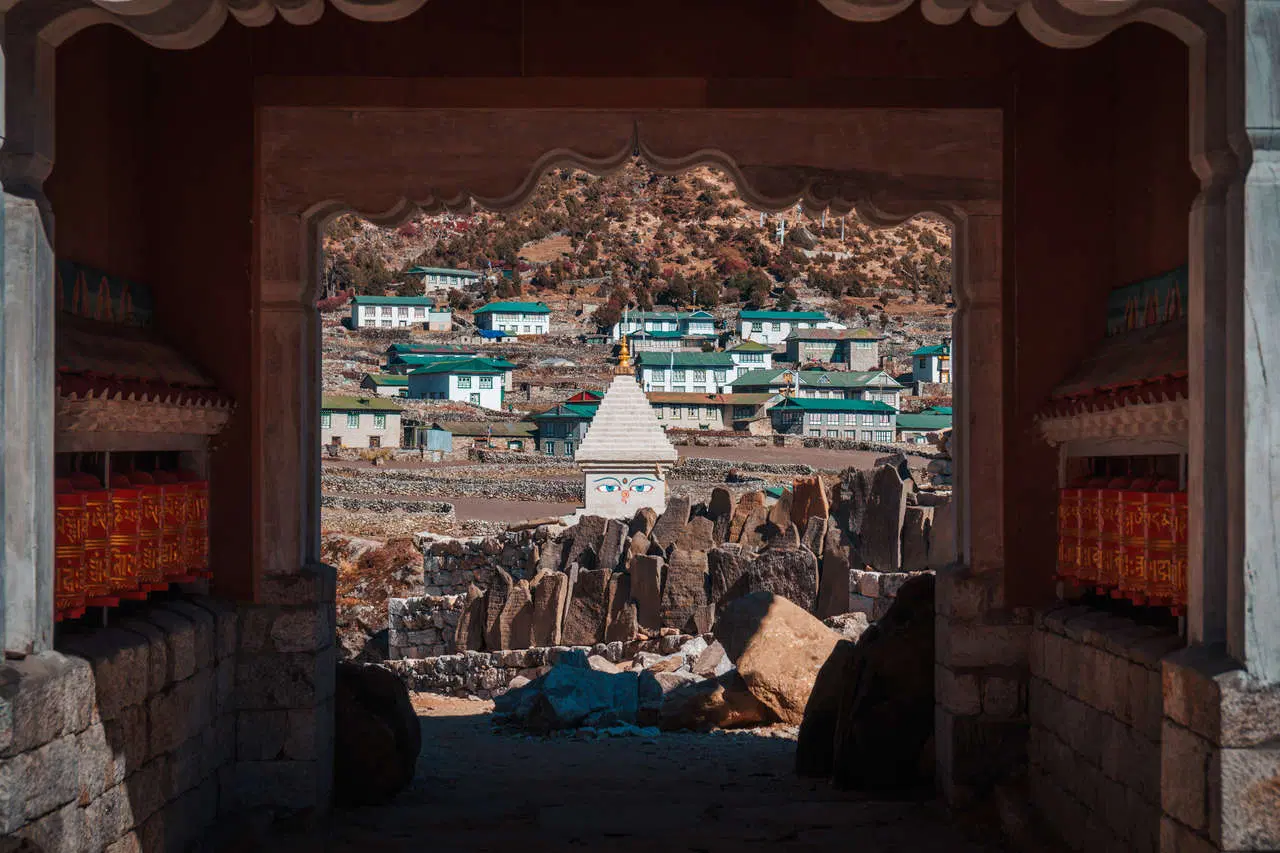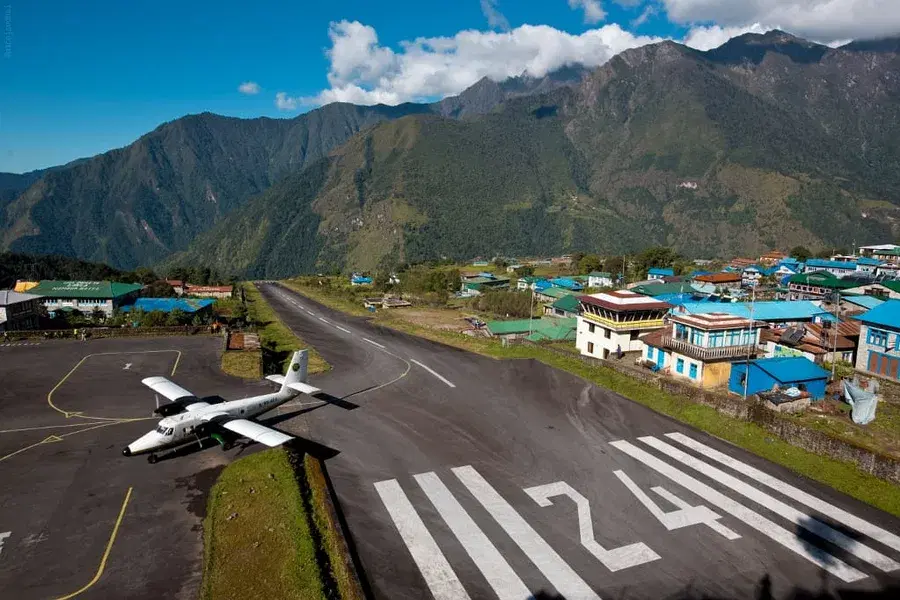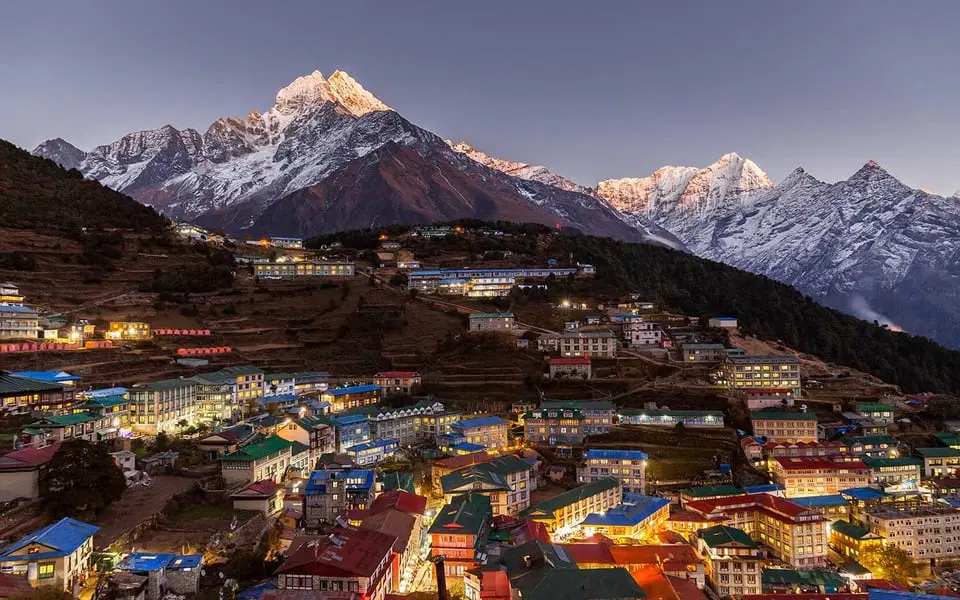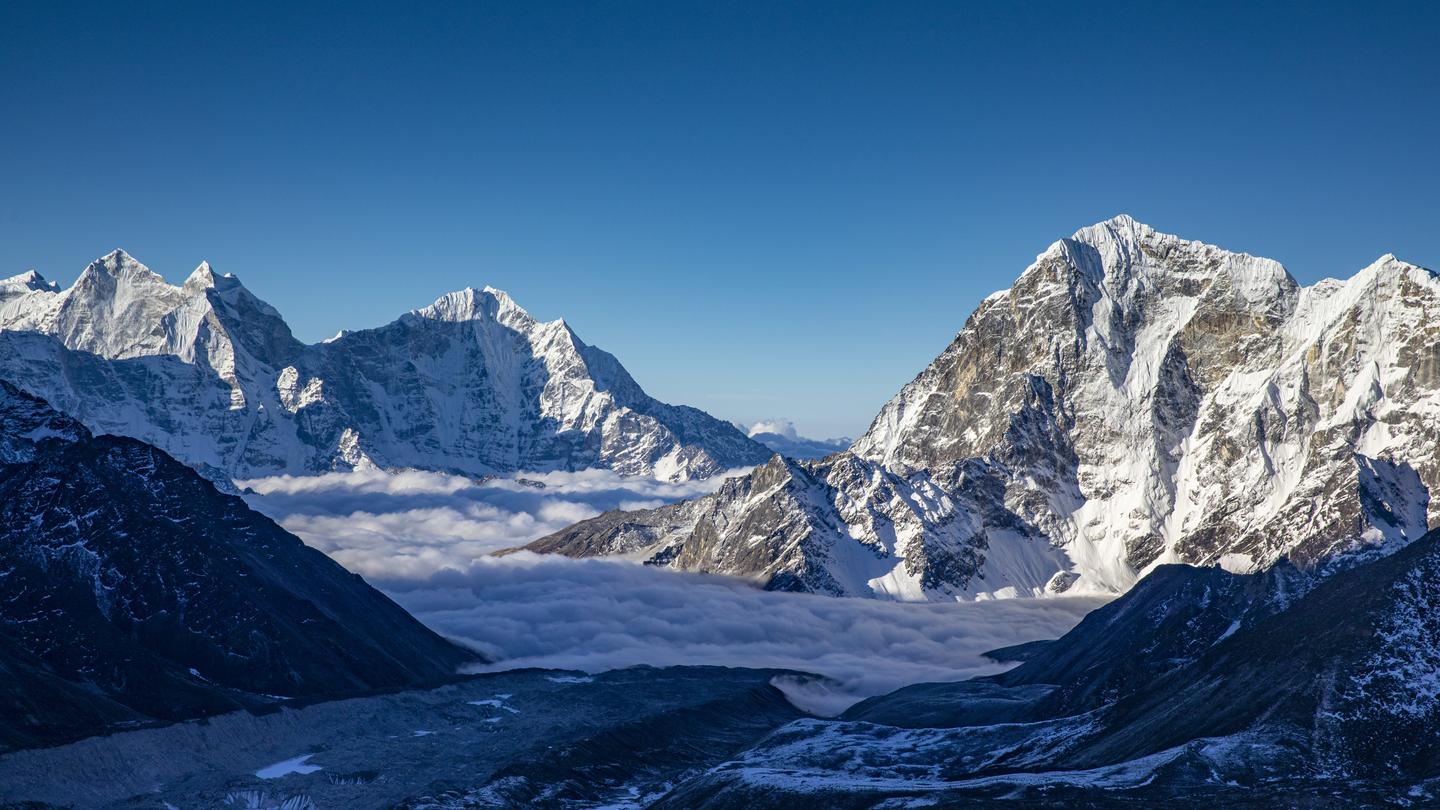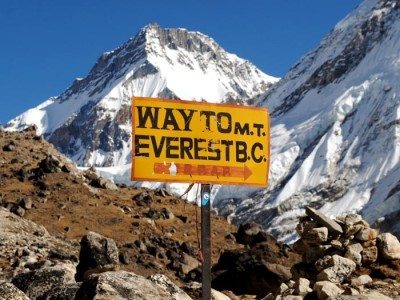Everest Base Camp Trek
Everest Base Camp trek organizer offers an awe-inspiring journey through the Himalayas, showcasing breathtaking landscapes, challenging terrain, and an immersive cultural experience amidst the world's tallest peaks.
Highlights of the Everest Base Camp Trek:
- Follow Sir Edmund Hillary's path to reach the top of the world's highest mountain.
- Climb Kala Pathar for amazing views of Mount Everest.
- Experience an exciting flight on the world's most adventurous route with the shortest runway.
- Visit the highest monastery, Tengboche, in the Khumbu Valley.
- Have a hassle-free trip with all paperwork and trekking permits sorted in advance.
- Breathtaking views of the Everest region.
- Get to know the gentle spirit of the Sherpa people.
- Suitable for people aged over 14 and below 65
Overview of Everest Base Camp Trek company:
Over 14 days of Everest Base Camp Trek, you'll trek to an elevation of about 5,644 meters, treating yourself to panoramic views of towering peaks like Pumori, Lhotse, Nuptse, Lobuche, and the iconic Mt Everest itself.
The adventure begins with a thrilling 35-minute flight from Kathmandu to Lukla during (January, February, May, June, July, August, September, December) or a quick 20-minute flight from Manthali/Ramechhap to Lukla during ( March, April, October, November). Manthali Airport is 6-hour drive from Kathmandu.
Starting and ending in Lukla, your journey of Everest Base Camp Trek follows the Dudh Koshi River, passing through Sagarmatha National Park en route to Namche Bazaar, a bustling trading hub and a spot for acclimatization.
Though the walk is challenging, the beauty of lush forests, farmlands, hills, and mountains will inspire you to keep going. After a day of acclimatization in Namche Bazaar, the Everest Base Camp Luxury trek continues to Tengboche, home to the renowned Tengboche Monastery. The path then leads to Dingboche and eventually to Lobuche, offering views of Lhotse, Nuptse, Makalu, Cho Oyu, Ama Dablam, and more.
Moving forward, you'll hike to Gorak Shep, walking alongside the Khumbu Glacier until you reach Everest Base Camp. Here, you can witness the world's deepest glacier, the Khumbu Glacier. After spending the night in Gorak Shep, the next day involves a hike up Kala Pathar to catch the sunrise over Mt. Everest and other peaks. Following this breathtaking experience, you'll return to Gorak Shep before descending to Pheriche Village.
Retracing your steps, you will trek down to Pheriche and head to Tengboche, continue to Namche, and finally Lukla. The adventure concludes with a flight back to Kathmandu, marking the end of an unforgettable Everest Base Camp Trek in Nepal.
Optional: For all the helicopter enthusiasts, you now have the option to take a luxurious and adventurous helicopter flight from Kathmandu to Lukla and back from Lukla to Kathmandu by paying an extra USD 350 PP one way. With this, you no longer have to worry about flights being delayed or canceled, which can happen every now and then due to bad weather.
Show more...During peak season (March, April, May, September, October, and November), flights to Lukla operates from Ramechhap/Manthali. Manthali is around 5 to 6 hours' drive from Kathmandu. In non-peak seasons (January, February, June, July, August, and December), flights to lukla operates from Kathmandu.
Outline Itinerary ( 14 Days ) Expand all +
Upon your arrival in Kathmandu, our representative will meet you at Tribhuvan International Airport, extend a warm welcome, and transfer to your hotel. Take advantage of this day to adjust to the new time zone and immerse yourself in the lively atmosphere of Kathmandu. Orientation Program will be at 5 PM. After orientation program welcome dinner with guide.
Show more...
Today is the beginning of your journey to Everest Base Camp Trek. You will take early flight to Lukla. Upon reaching Lukla enjoy the stunning mountain views. Start your Everest Base Camp trek to Phakding, descending through pine forests and picturesque Sherpa villages. Reach the delightful village of Phakding and settle into a tea house for the night. Make the most of the remaining daylight to explore Phakding. Wrap up your day with a satisfying dinner at the tea house
Show more...
Today's trek takes you further into the heart of the Khumbu region as you ascend along the Dudh Koshi River. Start your trek after breakfast, crossing suspension bridges and journeying through pine forests. Pass through the small check point of Monjo, verification of your entry into Sagarmatha National Park. Keep trekking alongside the Dudh Koshi River, passing through the village of Jorsalle. Commence the challenging ascent to Namche Bazaar after crossing Tenzing Hillary Suspension Bridge, featuring a steep climb with breathtaking views of Thamserku, Everest, and other peaks. Reach Namche Bazaar, a bustling market town and the commercial hub of the Khumbu region. Check into a tea house for your stay
Show more...
Acclimatization is vital for a successful trek to Everest Base Camp, and Namche Bazaar serves as an ideal spot for this purpose. Today is designated for relaxation and exploration, enabling your body to adapt to the higher altitude. Take a short hike to Everest View Hotel for better acclimatization. Explore Namche Bazaar and the Sherpa Museum in the afternoon. Stay hydrated by drinking lots of fluids. Have a taste of local Sherpa cuisine for dinner. Ensure a good night's sleep by going to bed early.
Show more...
Today trek takes you deeper into the Khumbu region, passing through picturesque landscapes and traditional Sherpa villages. You'll continue your ascent, reaching the village of Deboche, known for its serene monasteries and breathtaking views. Embark on your trek after breakfast from Namche Bazaar to Tengboche, trek uphill for panoramic views of Everest, Lhotse, and Ama Dablam, explore the peaceful Tengboche Monastery upon arrival, then move towards Deboche, cross the Imja River, and finally, check into a tea house for your overnight stay in Deboche.
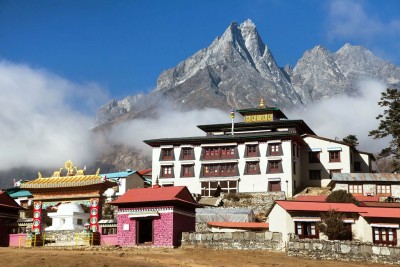
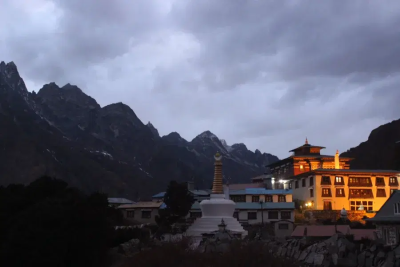
After staying overnight in Deboche, we head to Dingboche in the morning. The Everest Base Camp trek continues through the alpine forest to Deboche, where you cross Imja Khola (River) using a suspension bridge.
Later in the day, you'll enjoy a stunning view of Ama Dablam. You will climb to the village of Pangboche and follow the trail to Imja Valley. Finally, Reach Dingboche and check into a tea house in Dingboche for your overnight stay.
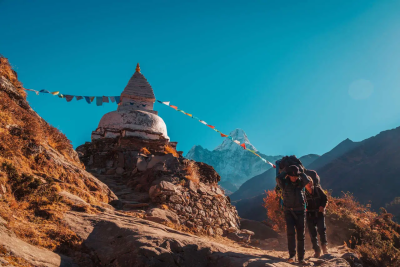

Acclimatization is essential for a safe and enjoyable trek at higher altitudes. Today is all about resting and exploring Dingboche, helping your body adapt to the rising elevation and getting you ready for the upcoming challenges.Start your day with a breakfast. For additional acclimatization, hike to Nangkartshang Peak, which provides views of Makalu, Lhotse, Cholatse, Tawache, and Ama Dablam. Stay hydrated, take it easy, read, or enjoy light activities during the day, then have dinner at the tea house.
Show more...
As you trek from Dingboche to Lobuche, you get closer to the Everest Base Camp. The landscape becomes rougher, and the air gets thinner as you travel through the high-altitude terrain. Begin the day with breakfast, get ready for the trek, ascend towards Thukla Pass to enjoy panoramic views of Pumori and Nuptse, take a lunch break in Thukla, continue trekking towards Lobuche. Check into a tea house for your overnight stay, and have dinner and sleep.
Show more...
Today is an important day as you finally reach Everest Base Camp. Start your morning trek after a filling breakfast in Lobuche, navigate rocky terrain as you ascend to Gorakshep, the last settlement before Everest Base Camp luxury trek. Check into the tea house for a quick lunch, then embark on the journey to Everest Base Camp through the Khumbu Glacier. Take time to capture memories with photographs at this incredible spot. After enjoying the Everest Base Camp luxury trek experience, trek back to Gorakshep, have dinner at the tea house in Gorak Shep, and rest early.
Show more...
Begin your day early to catch a stunning sunrise over the Himalayas at Kala Pathar and spend time taking photographs. Afterward, descend from Kala Patthar to Gorakshep, trek back down towards Pheriche, stop for lunch in the familiar spot of Lobuche, and finally, reach Pheriche to check into a tea house. Spend the evening resting and enjoy dinner at the tea house.
Show more...
Today, you'll continue your descent, making your way back to Namche Bazaar. Going down to lower altitudes brings a welcome relief, and you'll encounter familiar landscapes along the way. Check in at Hotel Sherpaland and have dinner.
Show more...
Today is the last part of your Everest Base Camp trek as you come down from Namche Bazaar to Lukla. The path goes through familiar villages and landscapes, giving you a chance to think about the amazing journey you've been on. Start your descent from Namche Bazaar after breakfast. Take breaks for tea, enjoy the scenic beauty, and catch glimpses of the mountains one last time. Have lunch in the charming village of Phakding. Continue your Everest 3 passes trek, crossing suspension bridges and passing through forests. Finally, arrive in Lukla, the gateway to the Everest region, and check into a tea house. Have a dinner celebration dinner with all crew members and sleep.
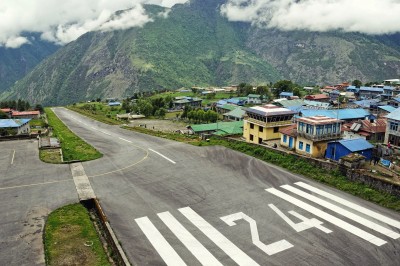
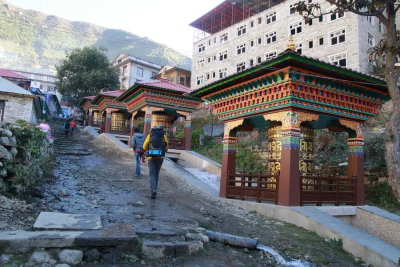
Take a morning flight from Lukla to Kathmandu. Explore Kathmandu, enjoy dinner and enjoy your last night in kathmandu. Once you land at the airport, you'll be transferrred to the hotel. Please note that flight operations are solely determined by the airline and may be influenced by the weather.
Show more...
Use your last morning in Kathmandu according to your flight time. Pack your things, check out of the hotel, Head to Tribhuvan International Airport for your departure. Wishing you a safe and pleasant journey back home!
Show more...Departures & Availability
What's inside the package?
Inclusions
Exclusions
Additional Information
An experienced English-speaking trekking guide
When you embark on this trek, you will be accompanied by a professional Everest Base Camp trek organizer and experienced English-speaking trekking guide who possesses excellent knowledge of the area and the trek itself. Our guides are skilled and have over 10 years of experience leading treks. They are friendly, courteous, and helpful, ensuring that you have a wonderfully memorable experience throughout your journey.
Supportive and reliable porters
To ensure your comfort during the trek, we maintain a porter-to-people ratio of 1:2, considering the group size. Each porter will carry a maximum of 12–15 kg of luggage per person. While the porters take care of your belongings, you will only need to carry a day pack containing your essentials, such as a wallet, camera, water bottle, dry snacks, a headlight, and other gadgets. We value the safety and well-being of our porters, and it is our collective responsibility to ensure their welfare. We kindly request that you only bring items that are absolutely necessary to reduce their burden.
Other Programs and Complimentary Services
In addition to the trek itself, we offer various programs and complimentary services to enhance your overall experience.
Welcome and Farewell Dinner: To make you feel at home and foster a sense of camaraderie, we arrange welcome and farewell dinners, where you can savor delicious local cuisine while sharing stories with fellow trekkers.
Trekking Permits
To embark on this trek, you will need to obtain two permits: the Trekking Information Management System (TIMS) permit and the Sagarmatha National Park Permit. Himalayan Social Journey will take care of arranging these permits for you. Please ensure that you carry a minimum of four passport-sized photos for the trekking permit checkpoints.
Travel Insurance
We strongly recommend obtaining a comprehensive travel insurance plan to cover any personal accountability, accidents, or illnesses that may occur during the trek. Depending on the nature of the activity, you may be required to provide a certificate of insurance for emergency assistance, medical support, evacuation, and search operations. Please note that such services are not provided for free in Nepal, and helicopter evacuation will only take place upon confirmation of insurance coverage.
Comfortable Accommodation for solo travellers
Throughout the tour, two people will be accommodated in each room. If you prefer private accommodation, you have the option to select the "single supplement" for an additional cost of USD 250.
Essential Info Expand all +
Our trek will be in a very beautiful part of the Everest region. Expect to trek about 5-7 hours daily, or about 8–12 KMS per day. Since beginners can also join the trip, it is recommended that you prepare for the trek by doing some suitable general training such as climbing hills or stairs, jogging, and spending some time in the gym to improve your stamina for a few months prior to the trek. If you are quite fit and do sufficient training prior to arriving in Nepal, the trek will be enjoyable, and it is suitable for fit people into their early 70's. This Everest Base camp trek company is the most popular for those wishing to get wonderful views of the Himalayan peaks. The Everest high pass trek altitude we reach is 5545 meters at Kalapatthar, which offers a breathtaking view of many of the world's greatest peaks. It is stunning! Any trekking equipment, such as walking poles, water bottles, and a rucksack, is very easily available in Kathmandu, near our hotel.
To be honest, you don't have to be a runner to enjoy the trek. But the preparation will probably save you a lot of pain and suffering on the trail and help you enjoy your experience there. The suggestions we have for physically preparing are to take good, long, brisk walks, preferably wearing a pack with a similar load that you'll be carrying. Cycling and swimming are also great alternatives, as is just about anything that gets your cardio working. Do some breathing exercises to get more oxygen into your lungs. Watch for signs of altitude sickness; symptoms include headaches, dizziness, sleeplessness, loss of appetite, and breathlessness. Bring a supply of the medication Diamox for treatment; if symptoms persist, descend. Trekking to Everest Base Camp may not be the right trip for everyone, as it is quite a physically demanding experience, and when you combine high altitude with plenty of climbs, you may get a recipe for suffering. But normal, average travelers can do the Everest Base Camp trek.
Most of the tea houses do have western-style flushing toilets. But in higher elevations, you may also find the traditional type of toilet made of either a ceramic basin on the ground or a few planks precariously positioned over a hole in the ground, which is situated outside the room.
You will get the facilities of hot and cold water running with an attached bathroom up to Namche without any extra charges. But above Namche, you will be charged about USD 5 for a hot water shower. It is not recomended to take shower above Dingbouche.
he maximum weight limit for the Lukla flight is 15 kg, which is equivalent to 33 pounds including your handbag (daypack). If your baggage exceeds the weight limits, additional costs of USD 1–2 per kg will be applicable, and the payment should be made at the airport counter itself.
Depending on when you plan to travel, it's important to have the proper clothes and be prepared for unexpected weather. Fairly well-worn hiking boots and shoes are a must! For tours between November and the first two weeks of March, bring a jacket suitable for -10 degrees Celsius. For tours at other times, please bring a jacket suitable for -3 to 5 degrees Celsius. Otherwise, the daytime weather will tend to be warm or pleasant.
A sleeping bag is necessary during the trekking days, and if you have your own sleeping bag, you can bring it. Otherwise, HSJ will provide you with a sleeping bag during the Everest Base Camp trek (-10 to -15 degrees).
In Kathmandu, we will be staying at the Himalayan Suite Hotel in Kathmandu. On the trek, we'll be staying at simple lodges run by Nepali families. During the trek, the bathrooms are outside the rooms, and hot water is dependent on solar panels, so don't count on many warm showers.
If you wish for better accommodations during the trek, you can upgrade the accommodations in the mountains. The upgrade will be at Yeti Mountain Home for 6 nights: Namche (3 nights), Phakding (2 nights), and Lukla (1 night). It costs USD 150 per night, including breakfast, service charge, and tax.
Most teahouses (lodges) in Everest region trails cook a delicious range of mostly vegetarian fare. Pasta, tuna bakes, noodles, potatoes, eggs, daal bhat (rice and lentils), bread, soup, fresh vegetables (variety depends on the season), and even some desserts like apple pies, pancakes, and some interesting attempts at custard. You will find a lot of garlic on the menu because it assists with acclimatization; eat some every day. In many villages, you may find some meat items on the menu. You can always get hot chocolate, tea, and hot lemon drinks, as well as soft drinks and treats like chocolate and crisps. One Meal costs USD 5-10
Yes, if you are a solo traveler and want to avoid a single supplement surcharge, you can share your room with a same-gender solo traveler. It, however, depends on the availability of another solo traveler and their willingness to share the room with you.
Generally, plan on spending around USD 15 to 20 per person each day. This covers expenses like water, tea or coffee, snacks, and hot showers in the mountains, as well as meals in Kathmandu. If you plan to shop for souvenirs or local Nepali goods, it's a good idea to bring some extra cash.
It's recommended to use Nepalese Rupees in cash rather than a credit card during mountain trekking. Exchange your currency to Nepali Rupees in Kathmandu before starting the trek, which you can do at the airport, banks, or your hotel. Keep in mind that there are ATMs up to Namche Bazaar, they can be unreliable, and you'll get a better currency exchange rate in Kathmandu.
When you book, you must pay a 20% deposit to secure your itinerary. The remaining balance can be paid upon your arrival at Kathmandu or before arrival.
There are no age restrictions for our treks as long as participants are healthy and willing. We welcome trekkers of all ages to join this amazing adventure. 7 years boy and 79 years man already successfully completed trek with us
It is safe for a female to trek alone in Nepal with guide.
Single supplimentry charge of USD 250 will be applicable for private room in mountain and in kathmandu.
Yes, attached toilets are available in teahouses at specific locations such as Lukla, Phakding, and Namche.
Many teahouses in the mountains provide vegetarian meals, so being a vegetarian is not an issue. Opting for vegetarian meals is recommended to prevent food poisoning and indigestion.
Certainly, teahouses offer hot boiled water at an additional cost ranging from USD 2 to 5 per liter. The price may vary, with higher altitudes incurring higher charges.
Some teahouses in the Everest region offer laundry services for an additional fee. Yet, there's no assurance that your clothes will dry on the same day. You can provide your clothes to laundry clothes during acclimatization days in Namche and Dingboche, it's advisable to pack sufficient clothes for the trek and not solely rely on laundry services.
Certainly, you can charge your equipment for free during the trek up to Namche. Beyond Namche, there will be a varying cost, typically around USD 1-5 per charge per device
We provide one guide for groups of up to 8 people, and for groups exceeding 8, an additional assistant guide is provided. The number of guides may be adjusted based on the group size. We assign one porter for every two clients, with each porter carrying the duffel bags of two clients. The weight limit is total 30kg or 15kg per client. If needed, at an extra cost, we can arrange for one porter to carry the duffel of a single participant.
Our guides are available 24/7 during the trek and are trained to use first aid kits and oxygen meters. They monitor the oxygen levels of clients, especially at Everest high pass trek altitudes, to ensure their well-being. In case of emergencies, we will bring you down to lukla by helicopter.
Yes, guesthouses at higher elevations provide oxygen at an additional cost if required. The oxygen cost can be significant, so we advise having travel insurance for potential reimbursement. Our guide will carry the portable oxygen can for emergency purpose.
Related Tours
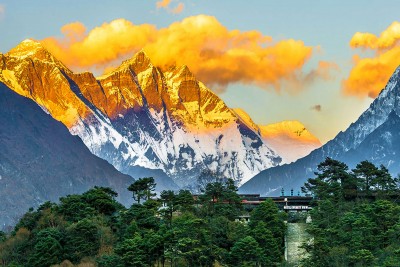
Everest Panorama Trek with Helicopter Tour
- Best Prices
- Easy Refund
7 days
USD
2,800
USD
2,299
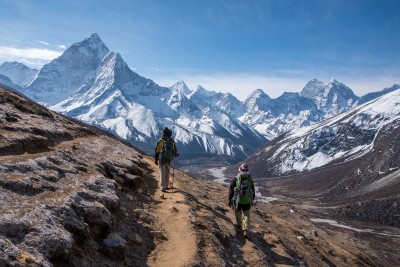
Everest Base Camp Trekking With Luxury 5 Star Wind Down
- Best Prices
- Easy Refund
15 days
USD
1,395
USD
1,095

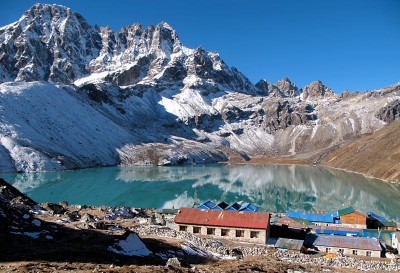
Gokyo Ri And Everest Base Camp Trek
- Best Prices
- Easy Refund
17 days

